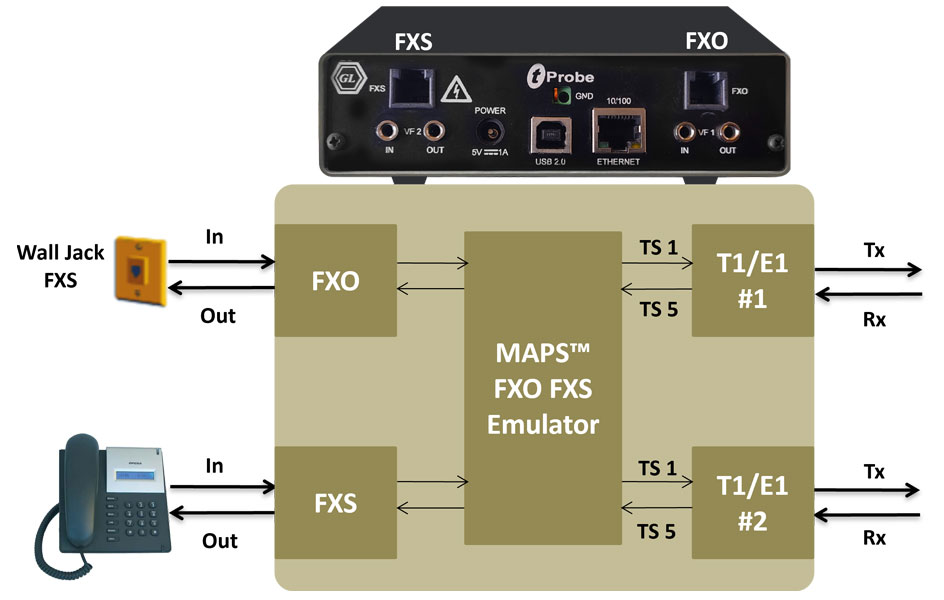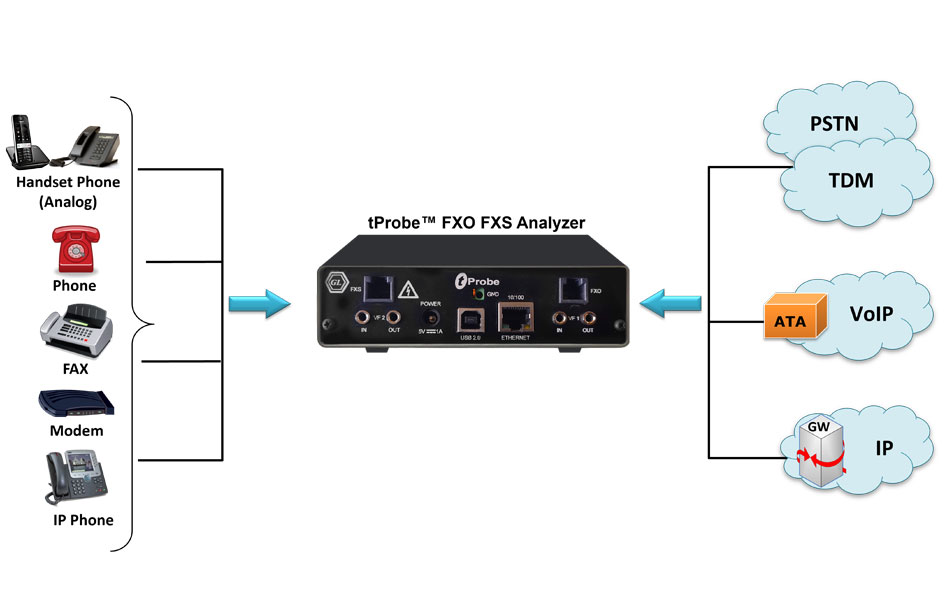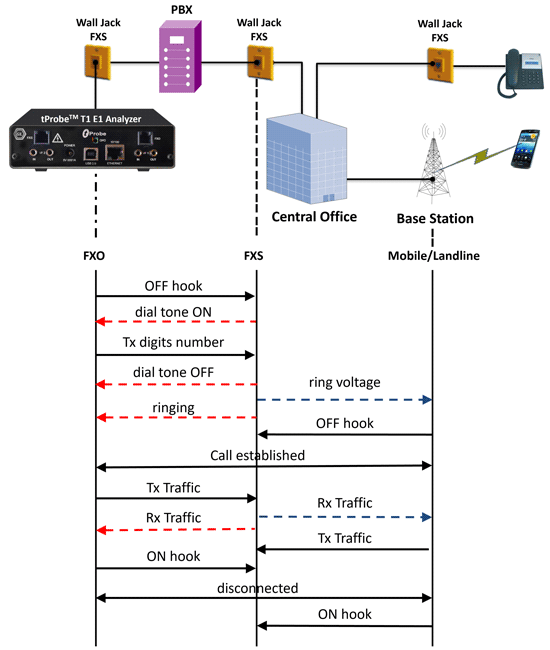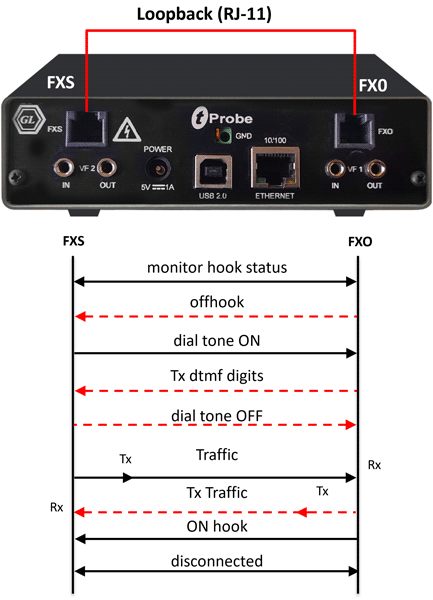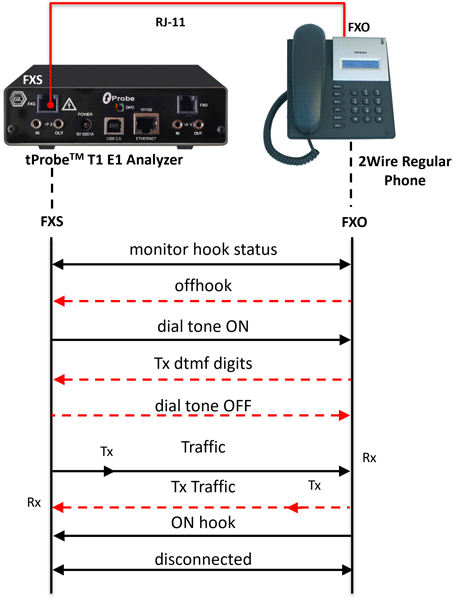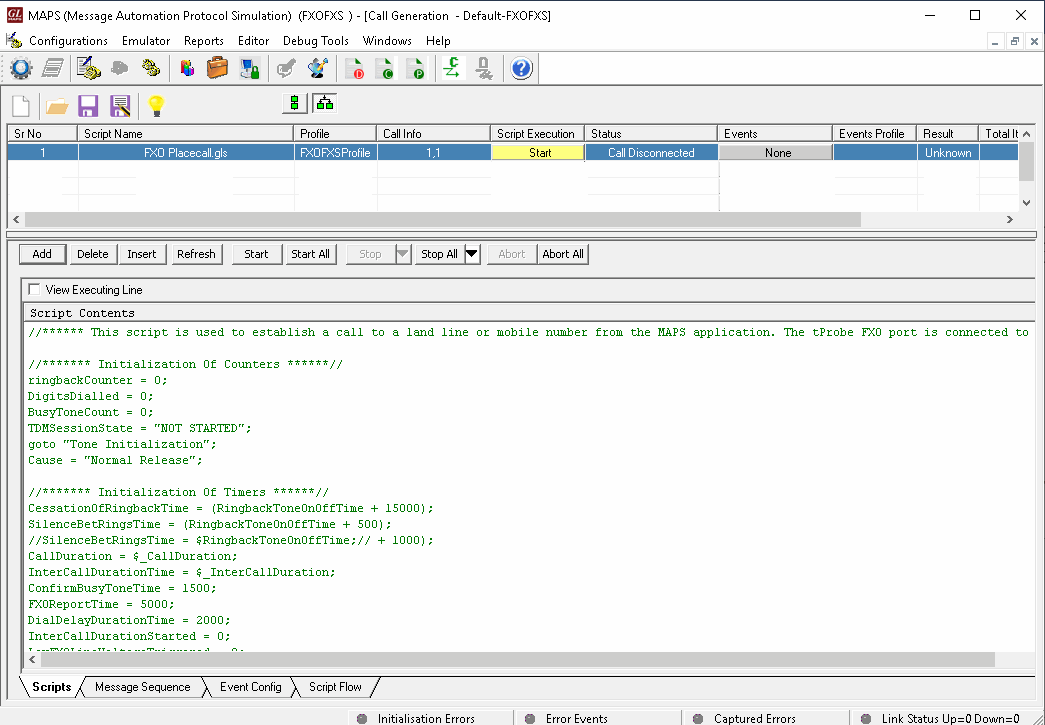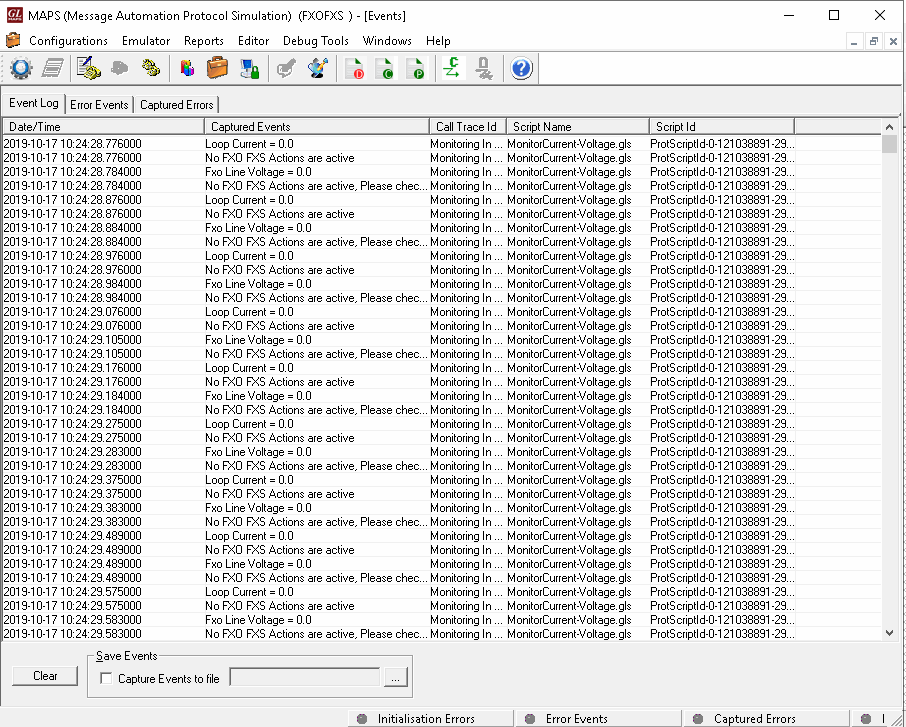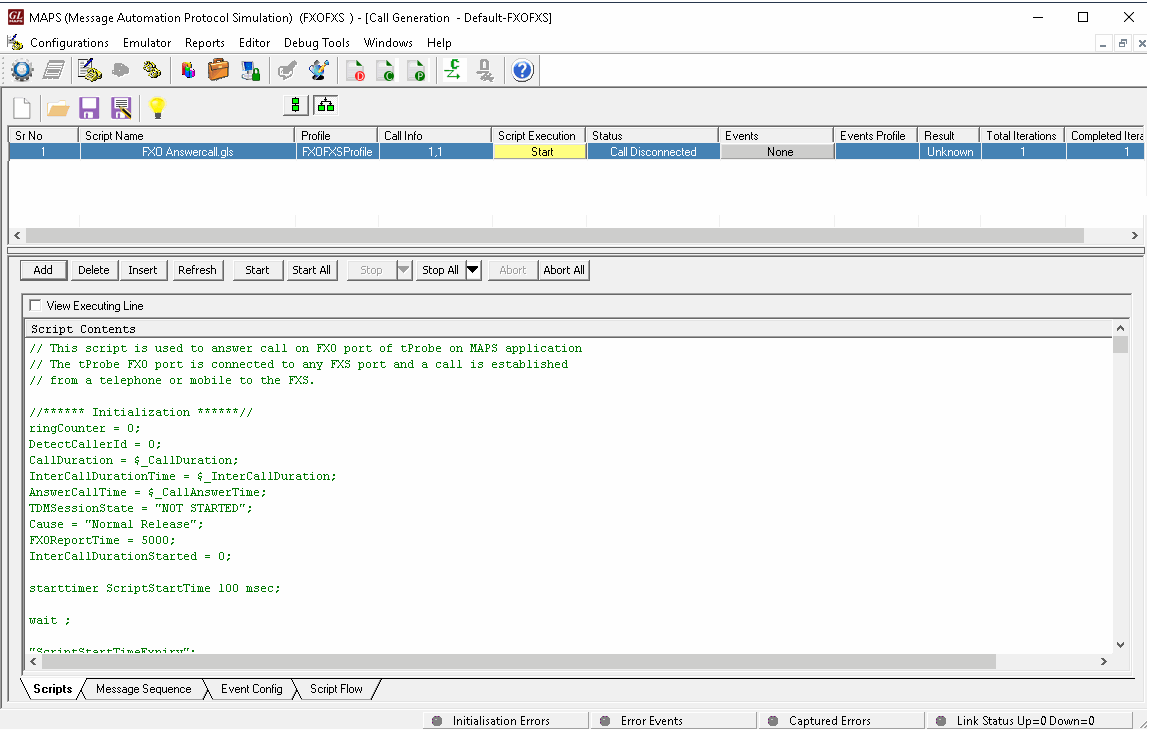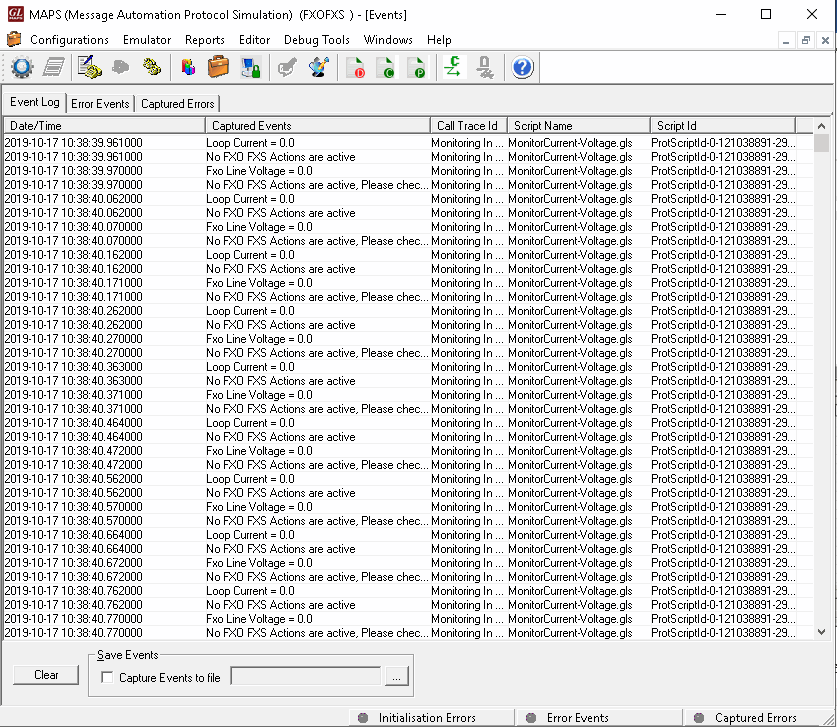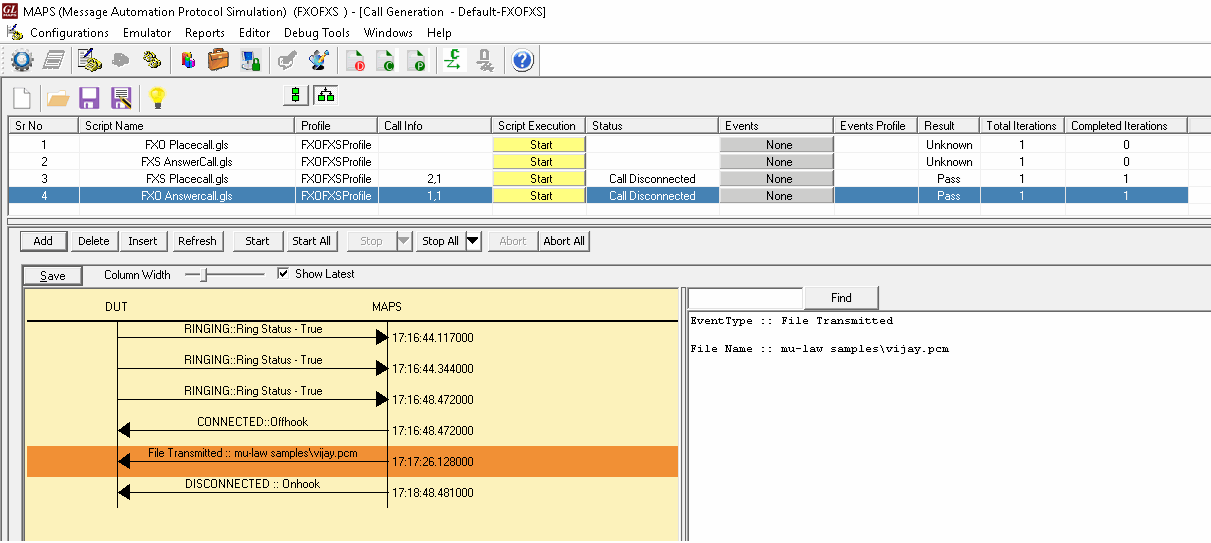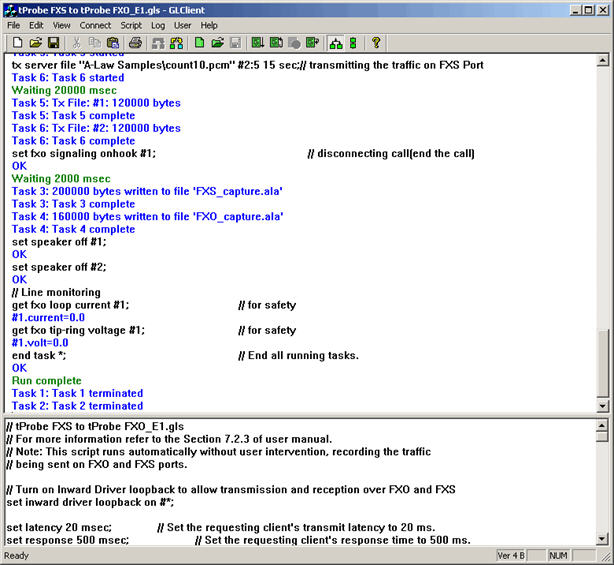MAPS™ FXO FXS
Emulate functions of Foreign Exchange Office (FXO) and Foreign Exchange Subscriber (FXS/Analog phone lines) using the FXO and FXS ports on a tProbe™
Request a Demo / Quote BrochureOverview
FXS and FXO are ports used by analog phone lines or phones. A Foreign Exchange Subscriber (FXS) port supplies ring voltage, battery current, dial tone and voice signals. Foreign Exchange Office (FXO) delivers an on-hook/off-hook indication (loop closure), DTMF digits, voice signals, and is usually a phone or fax machine.
The FXO and FXS ports on tProbe™ simulates all of the above features. Also, the FXO port on the tProbe™ permits non-intrusive capture and analysis of voice-band signals from a two-wire telephone line. The FXS port on tProbe™ emulates a two-wire FXS service such as a telephone wall jack.
GL's Message Automation & Protocol Simulation (MAPS™) platform is a general purpose protocol emulator tool for various protocols encountered in the telecom space. MAPS™ FXO FXS is one such advanced test tool that supports emulation of functions of Foreign Exchange Subscriber (FXS) by analog phone lines and Foreign Exchange Office (FXO) by phones using the FXO and FXS ports on a tProbe™ unit. MAPS™ place or answer incoming calls on both FXO and FXS ports and automate the entire testing process using scripts.
MAPS™ FXO FXS Emulator includes features to handle different types of traffic like tones, digits (DTMF, MF, MFR2F, MFR2B), voice files, fax, and more. Data width of the traffic being sent/ received over the FXO/FXS ports can be extended up to 16 bits to improve signal to noise performance. Also, GL’s MAPS™ FXO FXS application simulates CAMA trunks connected to the 911 selective router (SR) and can perform non-intrusive monitoring of 911 services. CAMA simulation capabilities include - seize the line, wait for wink, dial ANI, wait for call connect, detect seizure from far side, provide wink, wait for ANI, and connect the call. CAMA monitoring capabilities include - seizure and wink start detection, onhook and offhook detection and MF digit (ANI) detection.
Also refer to Analog Terminal (FXO) and Network Port (FXS) Testing using tProbe™ Client Server webpage for various FXO FXS testing scenarios using client server.
Main Features
- Script based simulation of 2-Wire Telephone Port (FXO) and Telephone Wall Jack (FXS) for complete automation
- GUI and CLI based testing of FXO/FXS for automation and remote access
- Stand-alone testing of FXO/FXS with loopback
- Supports input and output signals of 8K samples/sec, u-law, A-law, and 16-bit Linear PCM
- FXO/FXS termination supports for over 70 different termination characteristics (different countries)
- Functions supported by FXO port
- 'ON hook' and 'OFF hook' (loop closure)
- Transmit and Capture Traffic (Digits, Files, Tones, Fax, Dynamic VF, IVR, and VQT)
- 2-Wire Calling/Answering, Caller ID, T1 E1 to 2-Wire FXO Drop or Insert, PC to 2-Wire FXO Drop or Insert
- CAMA generation and monitoring capabilities include - seizure and wink start detection, onhook and offhook detection and MF digit (ANI) detection
- Functions supported by FXS port
- Detection of "ON hook" and "OFF hook" status
- Ring and Battery Voltage Generation, Dial Tone Generation
- Transmit and Capture Traffic (Digits, Files, Tones, Fax, Dynamic VF, IVR, and VQT)
- T1 E1 FXS Drop or Insert, PC to 2-Wire FXS Drop or Insert
- FXO FXS Simulation (both originating and termination calls) of CAMA Type Trunks for 911 Circuits
- FXO Monitoring of CAMA Type Trunks for 911 Circuits
- Handle FXO-FXS responses - Caller ID Detection, Continuous monitoring of Voltage and Current, and High and Low Voltage/Currents Triggers
- Loudspeaker provided to hear the voice being transmitted on FXO/FXS ports
- Enhanced to support voiceband measurements
- Send/Receive fax image (TIFF format) file over FXO and FXS ports
- Supports customization of place and answer calls using profile editor and script editor
- Ready-to-use scripts for quick testing
- Script based and protocol independent software architecture
- Provides call reports with associated captured events and error events during call simulation
- 1004 Hz Net Loss Tone test
- Attenuation Distortion (304-3004 Hz, 404-2804 Hz, and 504-2504 Hz) test
- Three Tone Slope (Gain Slope) test
- Signal/C-Notched Noise Level test
- Intermodulation Distortion (IMD) test
- Impulse Noise test
- Signal-to-Noise Ratio and Level test
- Twenty-three Tone test
Voiceband Measurement Capabilities:
Digital Signal Formats
FXO/FXS supports following digital signal formats:
- A-Law: This is the 8-bit codebook format typically used in E1 systems
- µ-Law: This is the 8-bit codebook format typically used in T1 systems
- 16-bit Linear: This is a 16-bit linear signal. Intel ("little-endian") byte ordering is used. (Currently this feature is supported only by FXO)
Applications
- Testing gateways, VoIP ATAs, telephone lines, handsets, VoIP PBX
- CAMA origination and termination side simulation to test CAMA type trunks
- Monitoring CAMA Trunks
- Voice quality testing, 2Wire call automation, Caller ID
- Monitoring signaling, voice, and tones on telephone lines non-intrusively
- Generation and reception of traffic on 2-Wire telephone lines
- Provides fault insertion, and erroneous call flows testing capability
- Ready scripts make testing procedure simpler, less time consuming and hence time to market products
- Remote operation of FXO FXS ports over TCP/IP
Testing tProbe™ FXO to Landline or Mobile Phone Connection via Local Exchange
In this scenario, the call is established to a landline or mobile number from tProbe™ FXO port using the MAPS™ scripts. The tProbe™ FXO port is connected to the wall FXS port. Through the local PBX and service provider's central office, the call is established to a mobile or landline number.
The call flow shown below depicts the call from tProbe™ FXO port to the Landline or Mobile phone through the wall jack FXS, local PBX, and central office of the service provider and base station.
With the MAPS™ FXO "Place Call" and "Answer Call" scripts, one can perform the basic operations during the call setup such as the Off-hook/On-hook, check dial tone, transmit DTMF digits, monitor ring signal, and handling traffic.
The "FXO Place Call" script initializes the FXO port parameters, places a call to pre-set number, and captures the traffic into the file and transmits traffic to the other end. The capture of traffic is started just after Off-hook and hence the dial tone, DTMF digits and voice traffic can be obtained in the file. The "FXO Answer Call " script basically initializes the FXO port parameters, monitors FXO ring signal and upon ring the call is received by asserting off-hook. The traffic is captured into the file and similarly a voice file is transmitted to the other end.
tProbe™ FXO port to tProbe™ FXO port via Teltone Switch (TLS 3)
It is also possible to establish call from tProbe™ FXO port to another tProbe™ FXO port via a Teltone Switch. Teltone Switch (TLS) provides two FXS ports in it and acts as a local exchange connecting the two lines.
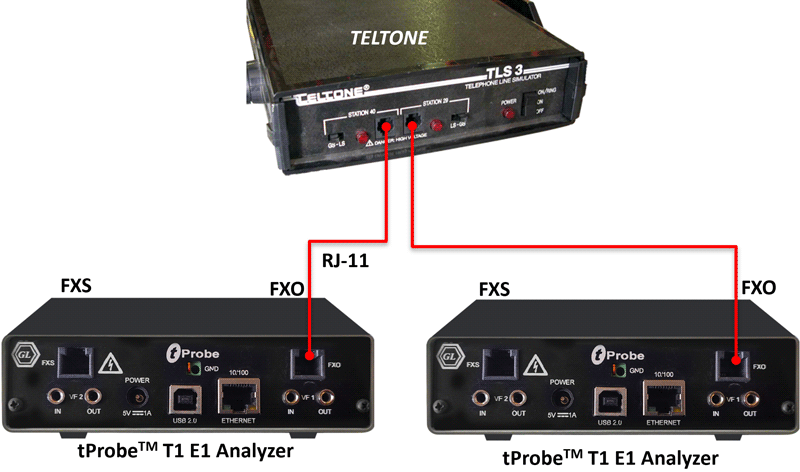
tProbe™ FXO port to tProbe™ FXO port via Teltone Switch (TLS 3)
tProbe™ FXO port to IP via ATA
FXO port is connected to VoIP phone or PC with a local network via an ATA device. The test scenario below depicts the call established between tProbe™ FXO port and VoIP phone via ATA.
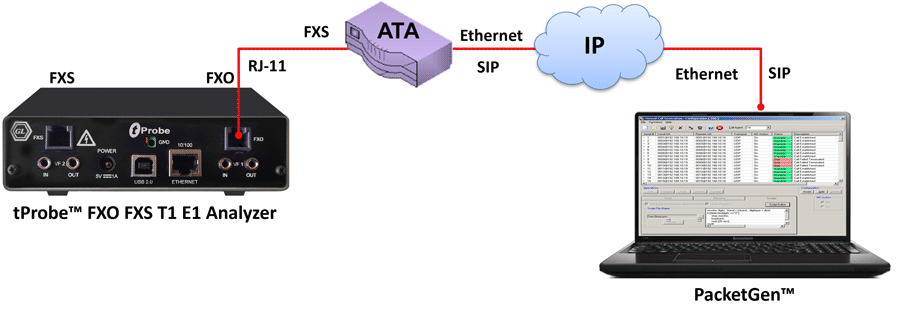
tProbe™ FXO port to IP via ATA
Testing tProbe™ FXO Port to tProbe™ FXS Port (Loopback)
Shown below is the call flow from tProbe™ FXO port to tProbe™ FXS port (connected in loop back) via RJ-11 cable.
MAPS™ FXO FXS Emulator can be used to accomplish the call between FXO and FXS in loopback connection. Script initializes tProbe™ FXO port and tProbe™ FXS port parameters, places the call from the tProbe™ FXO port to tProbe™ FXS port by sending DTMF digits, answers the call by asserting off-hook, captures the incoming traffic into the file and transmits traffic to the other end.
Testing tProbe™ FXS to Landline (2-wire phone)
In this scenario, the call is established to a landline from tProbe™ FXS port using the MAPS™ scripts. The tProbe™ FXS port is connected directly to the landline.
The call flow shown here depicts the call from tProbe™ FXS port to regular phone (2-wire phone) via RJ-11 cable.
The "FXS Place Call" and "FXS Answer Call" scripts in the MAPS™ FXO FXS Emulator are used for FXS testing. The "FXS Place Call" script basically places the ring to regular phone (2-wire phone) and upon off-hook, captures the incoming traffic into the file and transmits traffic to the other end. Similarly, "FXS Answer Call" script is used for answering a call on FXS port. The script basically initializes the FXS port parameters and answer to a call being placed from a FXO port. As soon as the Off-hook is detected on FXS port, a dial tone signal is sent to FXO port. The FXO port in turn sends DTMF digits. In ideal situation the FXS port transmits these DTMF digits to the local exchange, which in turn sends the ring signal to the called end.
tProbe™ FXS port to FXO port on GL's Dual UTA HD
Shown below is the call flow between tProbe™ FXS port to GL's Dual UTA HD via RJ-11 cable, with Dual UTA HD initiating the call. Dual UTA HD provides 2 wire FXO ports which can be used in testing telephone networks. The script places the call to the FXO port of the Dual UTA HD, captures the incoming traffic into the file and transmits traffic to the FXO port of the Dual UTA HD.
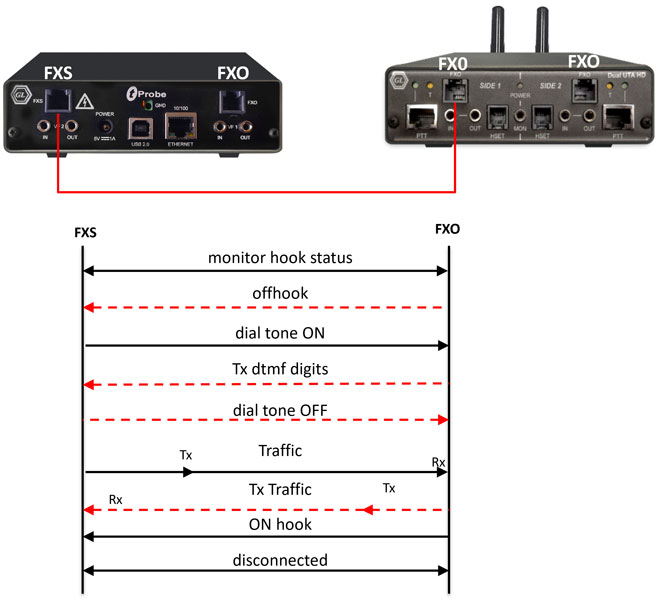
tProbe™ FXS port to FXO port on GL's Dual UTA HD
Fax Simulation over Analog Lines
MAPS™ FXO FXS application can be used to send/receive FAX to/from FAX machine over analog lines using tProbe™ FXO /FXS ports. tProbe™ FXO port is connected to telephone exchange via wall jack, while the FAX machine may be connected to one of the other telephone lines of exchange via wall jack. This operation also requires T1/E1 ports to be connected in loopback using cross-over cables.
Send/Receive FAX from/to tProbe™ FXO
MAPS™ "FXO Place Call" script calls the FAX machine by dialing the corresponding number. Thus a call is established between the tProbe™ and the FAX machine. The FAX generated on the Port 2 of the tProbe™ is loop backed to T1 (or E1) Port 1 of the tProbe™ through the crossover cable. This in turn is dropped on the FXO port, which is transmitted to the FAX machine.
MAPS™ "FXO Answer Call" script waits for the call and starts receiving the FAX once the call is established. The actual FAX reception happens on the T1 (or E1) Port 2 of the tProbe™, via the T1 (or E1) Port 1 and FXO port.
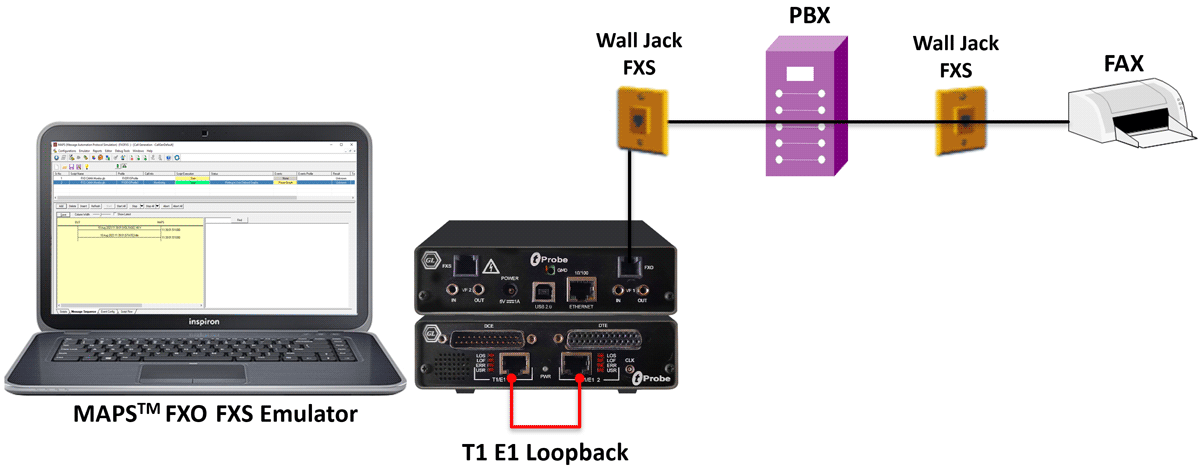
Send/Receive FAX over FXO Port
Send/Receive FAX from/to tProbe™ FXS
The MAPS™ "FXS Place Call" script calls the FAX machine by placing a ring on it. On detection of off-hook, the connection is established between the tProbe™ and the FAX machine. The FAX generated on the T1 (or E1) Port 1 of the tProbe™ is loop backed to T1 (or E1) Port 2 of the tProbe™ via the crossover cable. This in turn is dropped on the FXS port, which is transmitted to the FAX machine.
The "FXS Answer Call" script basically waits for the offhook and DTMF digits. Once a DTMF digit is detected a call is established and starts receiving the FAX. The actual FAX reception happens on the T1 (or E1) Port 1 of the tProbe™ via the T1 (or E1) Port 2 and FXS port.
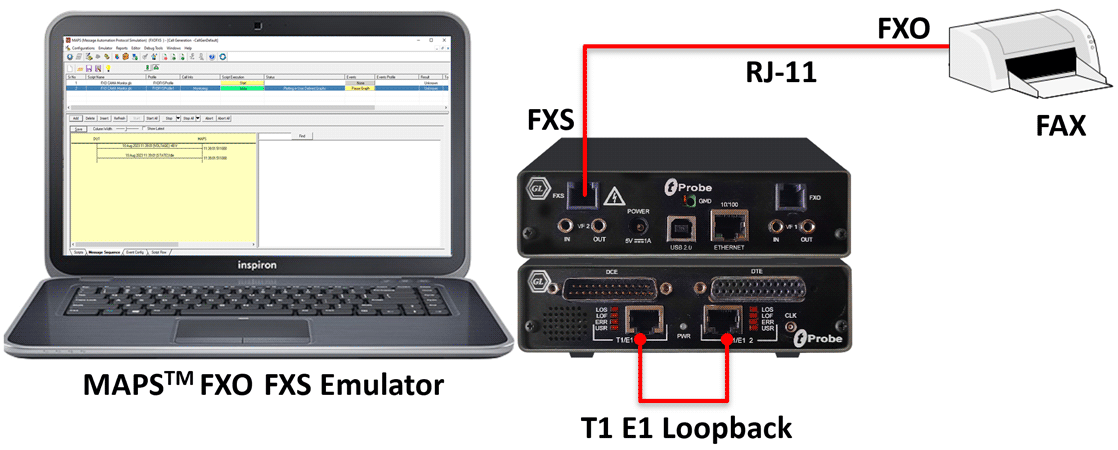
Send/Receive FAX over FXS Port
FXO Simulation of CAMA type trunks for 9-1-1 circuits
CAMA (Centralized Automatic Message Accounting) is a special analog trunk, originally developed for long-distance billing, but is now mainly used for emergency call services: 911 and Enhanced 911 (E-911).
The tProbe™ FXO port can be directly connected to 911 selective router or PSAP on CAMA-type circuits for simulation of CAMA calls to the selective router or PSAP. The script will seize the line, wait for wink, dial ANI and wait for call connect.
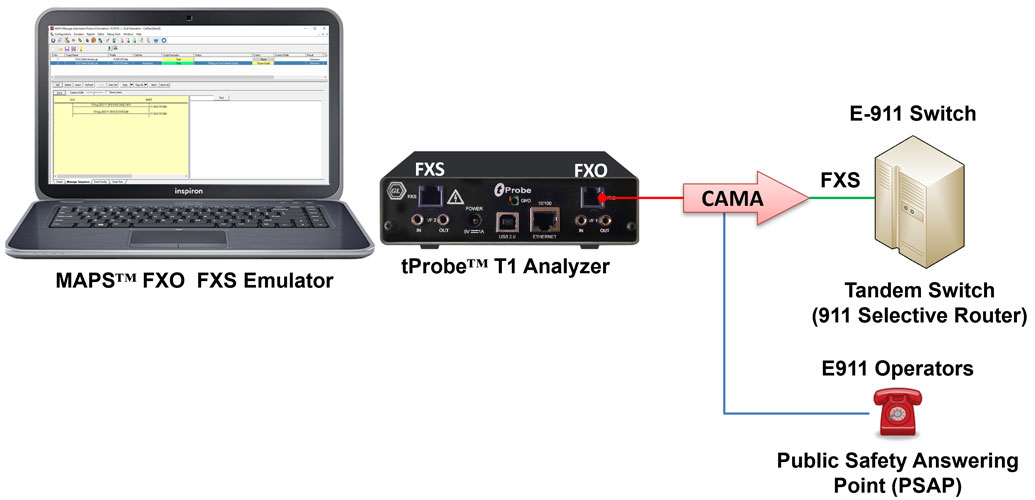
Originating CAMA Calls Simulation (FXO ports)
The figure below shows tProbe™ FXS port connected to central office or selective router for terminating CAMA calls. The script will detect seizure from far side, provide wink, wait for ANI, and connect the call.
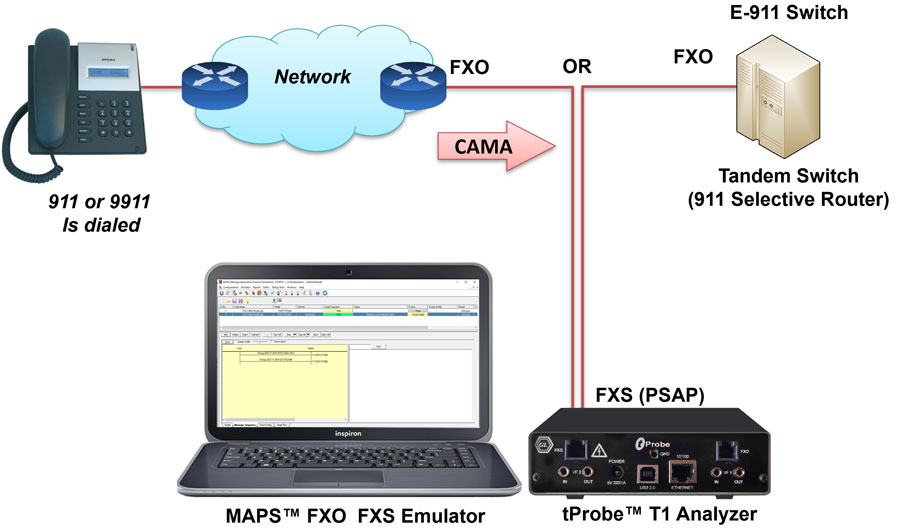
Terminating CAMA calls Simulation (FXS ports)
The MAPS™ FXO FXS Emulator application displays a real-time signaling sequence of the CAMA type trunk connected to the 911 Selective Route as shown below.
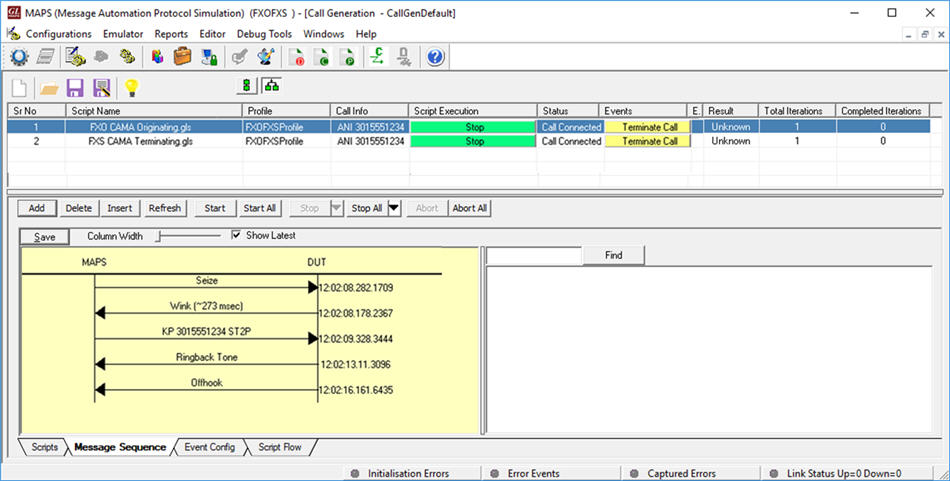
FXO CAMA Simulation Message Sequence
FXO Monitoring of CAMA type trunks for 9-1-1 circuits
CAMA (Centralized Automatic Message Accounting) is a special analog trunk, originally developed for long-distance billing, but is now mainly used for emergency call services: 911 and Enhanced 911 (E-911).
GL’s MAPS™ FXO FXS application with T1 Analyzer unit (tProbe hardware) can be used for non-intrusive monitoring. The tProbe™ FXO port can be tapped onto CAMA-type circuits for non-intrusive monitoring of 9-1-1 service. CAMA monitoring capabilities include seizure and wink start detection, onhook and offhook detection and MF digit (calling party ANI) detection. A normal analog call is routed based on the destination (called party) phone number. However, 911 calls are routed based on the calling party number.
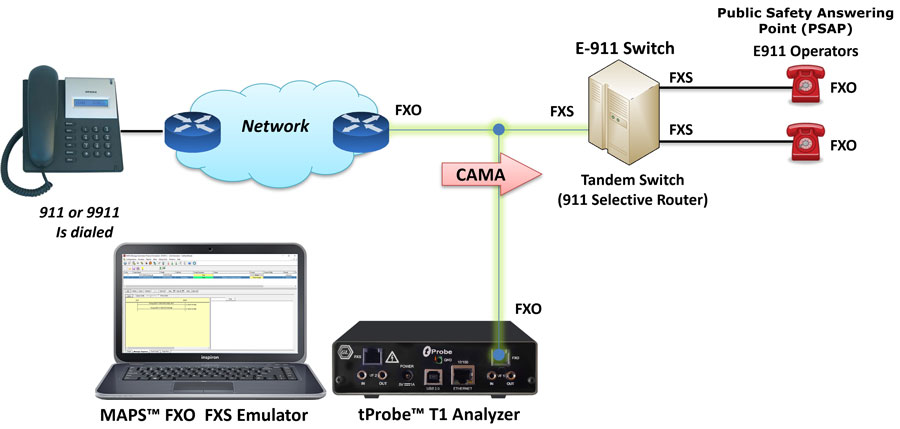
FXO Monitoring of CAMA type trunks
CAMA type signaling is used for provisioning private switch 9-1-1 service in conjunction with the use of Private Branch Exchange (PBX) telephone systems. Typically used CAMA-type circuits is one where the CAMA type trunks are connected to the 9-1-1 tandom switch (Selective Router).
ANI signal (in the form of MF tones) is used to pass station identification to the public switched network.
For CAMA circuits connected to the E-9-1-1, this is defined as:
KP-I-NXX-XXXX-ST
Where, KP indicates a KP (key pulse) signal
I - information digit
NXX - the prefix of the telephone number (exchange)
XXXX - the caller’s PBX station number
ST - indicates a ST (start pulse)
A typical signaling sequence for CAMA type trunks connected to the 9-1-1 switch is as shown below:
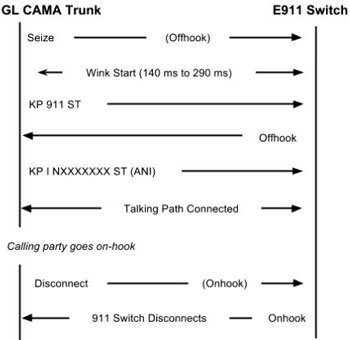
Typical CAMA type trunk signaling sequence (NENA 03-502)
Typically, there are 5 CAMA signaling types based on the number of digits in ANI, these include, 7-digit transmission (kp-0-nxx-xxxx-st), 8-digit transmission (KP-npd-nxx-xxxx-st), 10-digit transmission (kp-0-npa-nxx-xxxx-st), 20-digit transmission (kp-0-npa-nxx-xxxx-st-kp-yyy-yyy-yyyy-st), and kp–2–st (indicates a failure to receive ANI).
The following screen depicts a call monitoring process of a 10-digit ANI transmission using MAPS™ FXO FXS application.

In addition, a live graphical view of the captured line voltage is displayed in User Defined Graphs.
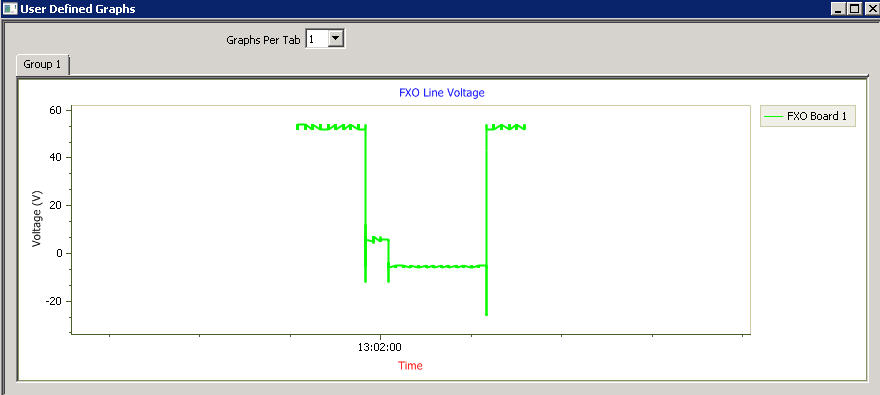
FXO CAMA Signal Monitoring
FXO Place and Answer Call Procedures
Call Generation feature allows the user to simulate incoming and outgoing communications in the test network using place/answer call scripts and profiles. The profile allows necessary parameters of call controls to be changed during runtime.
MAPS™ FXO Placing Call to Phone (via Central Office)
MAPS™ FXO FXS Emulator is configured with FXO_placecall.gls script is used to establish a call to an analog phone connected via central office. The tProbe™ FXO port is connected to the wall FXS port.
MAPS™ provides Event Log, Error Events, and Captured Errors report encountered during the progress of the call.
MAPS™ FXO Answering Call from Phone (via Central Office)
MAPS™ FXO FXS application is configured with FXO answer call script to detect incoming traffic from the analog phone connected via central office. The ready scripts used can detect events and respond with appropriate actions with respect to the states. The tProbe™ FXO port is connected to wall jack FXS and a call is established from a telephone to the tProbe™ via central office.
The Events encountered during the progress of the calls are logged as seen in the screen below.
Ringing 20 Hz Frequency Procedure
As illustrated in the test scenario below, FXO port on tProbe is connected to the FXS port on the Switch (DUT) using the RJ11 cable. Teltone Switch (TLS) provides two FXS ports in it and acts as a local exchange connecting the two lines. In this test scenario, the call is placed from the FXS Switch side and is received on the FXO side. MAPS™ FXO FXS emulator on the FXO receiving terminal is configured to receive the incoming call after 20Hz ringing. The send file traffic is initiated from the FXS terminal over the established call. The voice file is received in MAPS™ FXO Emulator and is saved for analysis.

Loop Start Call Procedure
As illustrated in the test scenario below, FXO port on tProbe is connected to the FXS port on the Switch (DUT) using the RJ11 cable. Teltone Switch (TLS) provides two FXS ports in it and acts as a local exchange connecting the two lines. In this test scenario, the call is placed from the FXO Switch side and is received on the FXS side. MAPS™ FXO FXS emulator on the FXS receiving terminal is configured to receive the incoming call. The send file traffic is initiated from the FXO terminal over the established call. The voice file is received in MAPS™ FXS Emulator and is saved for analysis.

FXO and FXS Testing using tProbe™ Client Server
tProbe™ WCS commands can be used to set up different types of FXO and FXS environment and to perform FXO and FXS specific operations.
The FXO and FXS ports on tProbe™ allows to simulate various features using WCS scripting. A Foreign Exchange Subscriber (FXS) port supplies ring voltage, battery current, dial tone and voice signals. Foreign Exchange Office (FXO) delivers an on-hook/off-hook indication (loop closure), DTMF digits, voice signals, and is usually a phone or fax machine.
The major tasks performed by tProbe™ FXO port are "ON hook" and "OFF hook" indications (loop closure) and transmitting DTMF digits (i.e. dialing the telephone number). Apart from this tProbe™ FXO port can also capture the incoming traffic into the file (i.e. A-law or Mu-law formats). It can also transmit traffic like, tones, noise and voice files (i.e. A-law or Mu-law formats).
The tProbe™ FXS port performs operations like detecting "ON hook" and "OFF hook" status of the FXO device, supplies ring voltage, dial tone and battery current. Apart from this tProbe™ FXS port can capture incoming traffic into the file (i.e. A-law or Mu-law format) and it can also transmit the traffic like tones, noise and voice files (i.e. A-law or Mu-law format).
Download sample script for initializing and setting the parameters for FXO using WCS.
Resources
Please Note: The XX in Item No. refers to the hardware platform, listed at the bottom of the Buyer's Guide, which the software will be running on. Therefore, XX can either be ETA or EEA (Octal/Quad Boards), PTA or PEA (tProbe Units), UTA or UEA (USB Units), HUT or HUE (Universal Cards), and HDT or HDE (HD cards) depending upon the hardware.
| Item No. | Item Description |
| XX624 | MAPS™ FXO FXS Emulator (only for tProbe)™ |
| PTA001 | T1 Software for tProbe™ (w/Basic Software for WIN 10) |
| PEA001 | E1 Software for tProbe™ (w/Basic Software for WIN 10) |
| XX610 | w/ Transmit and Receive File capability |
| XX620 | w/ DTMF/MF/MFC-R2 + answer/place call capability |
| Item No. | Related Hardware |
| PTE001 | tProbe™ Dual T1 E1 Analyzer (Portable USB Unit) |
| PTE015 | w/ 2Wire FXO and FXS Optional Board; uses XX600, requires XX624 (MAPS™ FXO FXS) |
| Brochures |
| MAPS™ FXO FXS - Brochure |
| 2-Wire Analog Bulk Call Generator Brochure |
| GL Product Lists |
| Presentations |
| Analog FXO FXS Testing using MAPS™ Presentation |
| Webinars |
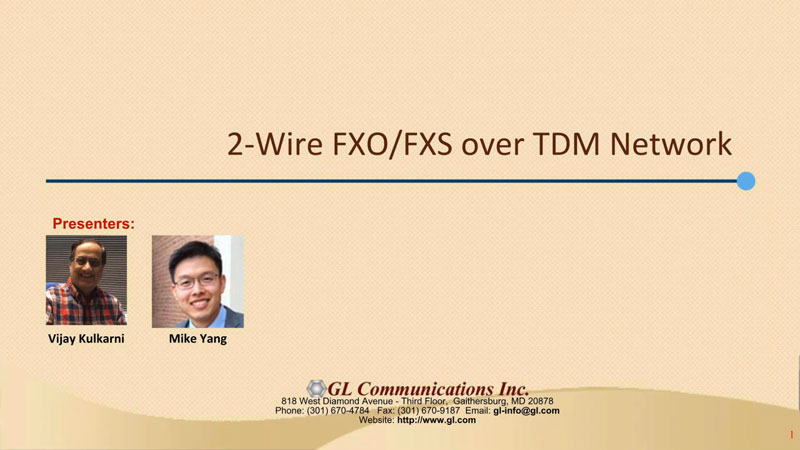
|
